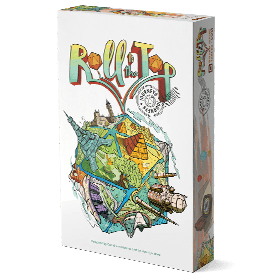롤 투 더 탑: 여정
 기자의 피라미드부터 마터호른까지, 세계 곳곳의 관광지로 떠나보세요. 집에 있는 가족에게 보낸 여행길을 되짚는 엽서를 채우며 젊은 예술가의 여행길을 따라갑니다.
기자의 피라미드부터 마터호른까지, 세계 곳곳의 관광지로 떠나보세요. 집에 있는 가족에게 보낸 여행길을 되짚는 엽서를 채우며 젊은 예술가의 여행길을 따라갑니다.
롤 투 더 탑에서는 모두 같은 주사위 묶음을 써서 각각 여행 게임판을 채웁니다. 칸을 채울 때는 바로 밑에 있는 칸보다 더 높은 숫자를 적어야 한다는 규칙에 주의하세요!
가장 먼저 게임판을 꽉 채운 사람이 승리합니다.
플레이어 수: 1 - 6
게임 시간: 8 mn
복잡성: 0 / 5
롤 투 더 탑: 여정 및 다른 게임 1194개를 온라인으로 즐겨보세요.
다운로드가 필요없으며, 웹 브라우저에서 바로 플레이할 수 있습니다.
친구들과 그리고 전세계의 수많은 게이머들과.
무료.

롤 투 더 탑: 여정 및 다른 게임 1194개를 온라인으로 즐겨보세요.
다운로드가 필요없으며, 웹 브라우저에서 바로 플레이할 수 있습니다.
친구들과 그리고 전세계의 수많은 게이머들과.
무료.

규칙 요약
OVERVIEW
Roll to the Top: Journeys is a roll and write game. Dice rolls determine the numbers available to play with and you decide which ones to place on your board and where to place them. The goal is to be the first to fill all the spaces on your board.
THE DICE
There are 5 number dice and one action die. Each turn, the Action Die and anywhere from one (1) to five (5) number dice are rolled. Players take turns deciding which die to add or remove for the following turn’s roll, based on the results of the Action Die.
Action Die
The Action Die is rolled along with the number die or dice and results in the active player taking one of three possible actions: add a die to the active pool, remove a die from the active pool, or swap an inactive die with an active one.
It is a six-sided die with 2 opportunities to roll the + (add), 2 opportunities to roll the – (remove), one opportunity to swap (indicated by the blue arrows pointing in opposite directions), and one opportunity for +/- which allows the active player to choose whether to add or remove a die.
There are three scenarios where the action is already determined, regardless of the action die. These are:
- If all 5 dice are already in the active pool, the active player must remove a die.
- If only one die is in play, the active player must add one.
- If no player writes a number on their board, the active player must add a die.
- If none of these three scenarios apply, the active player will take the direction indicated by the result of the rolled action die.
Number Dice
There are 5 dice, each with different number values, as follows:
- d4 (4-sided die) with the numbers 1, 2, 3, and 4
- d6 (6-sided die) with the numbers 1,2,3,4,5, and 6
- d8 (8-sided die) with numbers 1 through 8
- d12 (12-sided die) with numbers 1 through 12
- d20 (20-sided die) with numbers 1 through 20
GAME PLAY
Each turn, the active dice are rolled and all players, simultaneously, use the numbers to fill spaces on their board.
Players can use some, all, or none of the numbers rolled each turned. Numbers can be added to create larger numbers, but no number can be used more than once.
Example: The dice roll results in a 2, 5, and 5. Players can place each separately on their board, or they can place 2 and 10 or 5 and 7. They would not be able to place a 2, 5, and 7.
Once all players have chosen and placed their numbers, the active player (the one who hold the action die) makes their choice to add, remove, or swap dice based on the instructions of the action die and the rules above. Then the dice are rolled and a new turn starts.
Filling Spaces with Numbers
When placing numbers on the board, players must follow these rules:
- Each box can contain a single number
- Dice results can be used on their own or added together to make greater numbers
- Each dice can only be used once, regardless of if it’s used on its own or combined with others
- You don't have to use all of the numbers if you don't want to, and can even choose not to play any of the rolled numbers
Placement Restrictions
Boxes with dots in their lower right corner can contain any number. All other boxes have the following restrictions:
- You can only fill a space when the box(es) supporting it below have a number in them.
- Players can only place numbers which are greater than or equal to the number(s) below it.
- Spaces that don’t sit on any other space, are considered hanging spaces. Hanging can contain any number, similar to the starting spaces with dots. The difference is that since spaces don’t sit on others, they can’t be filled until an adjacent space to its right or left is filled.
GAME END
The games ends when one or more players fill every space on their board. The winner is determined when the turn is over, so if more than one player fills their board in the same turn the result is a tie.

